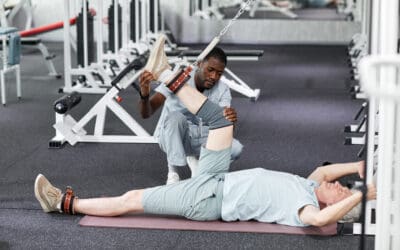Osteopathy is a type of manual therapy that emphasizes the body’s ability to heal itself. It is a holistic approach to pain management and overall well-being that aims to improve the body’s musculoskeletal function by using gentle, non-invasive techniques.
Osteopathy believes that the body has the natural ability to heal itself, and by promoting better function in the musculoskeletal system, it can restore balance and overall wellness.
Osteopathy works by addressing the root cause of pain, rather than just treating the symptoms. Osteopathic practitioners use their hands to manipulate the body’s tissues, muscles, and joints to improve circulation, reduce inflammation, and promote healing.
By using a combination of massage, stretching, and gentle pressure, osteopathy can help relieve pain, improve mobility, and promote overall wellness.
The Benefits of Osteopathy
- Reduces Pain
Osteopathy is an effective way to reduce pain, especially chronic pain. By using non-invasive techniques to manipulate the body’s tissues and joints, osteopathy can help reduce pain and inflammation without relying on medications. It is particularly effective for conditions such as back pain, neck pain, and headaches.
- Improves Mobility
Osteopathy can also help improve mobility by addressing issues with the musculoskeletal system. Osteopathic practitioners use techniques like joint mobilization and stretching to improve joint mobility and flexibility, reduce stiffness, and increase range of motion.
- Reduces Stress
Osteopathy can also help reduce stress. The gentle techniques used in osteopathy can help promote relaxation and reduce tension in the body, which can help reduce stress and promote a sense of well-being.
- Promotes Healing
Osteopathy is a holistic approach that focuses on the body’s natural ability to heal itself. By addressing issues with the musculoskeletal system, osteopathy can help promote healing and reduce the risk of future injuries. Osteopathy can also help improve circulation, promoting the delivery of nutrients and oxygen to the body’s tissues, which can aid in healing.
- Improves Posture
Osteopathy can also help improve posture. Osteopathic practitioners use techniques to realign the body and improve spinal alignment, which can reduce strain on the muscles and improve posture.
How Osteopathy Can Help with Specific Conditions
- Back Pain
Osteopathy can be an effective treatment for back pain. By addressing imbalances in the musculoskeletal system, osteopathy can help reduce pain, increase mobility, and promote healing. Osteopathic practitioners use gentle techniques to manipulate the spine, muscles, and tissues to help relieve pain and improve function.
- Neck Pain
Osteopathy can also be effective in treating neck pain. By addressing imbalances in the musculoskeletal system, osteopathy can help reduce pain, improve mobility, and promote healing. Osteopathic practitioners use gentle techniques to manipulate the neck, muscles, and tissues to help relieve pain and improve function.
- Headaches
Osteopathy can also help reduce the frequency and severity of headaches. By addressing imbalances in the musculoskeletal system, osteopathy can help reduce tension and inflammation, which can contribute to headaches. Osteopathic practitioners use gentle techniques to manipulate the head, neck, and shoulders to help relieve pain and reduce the frequency of headaches.
- Sports Injuries
Osteopathy can be an effective treatment for sports injuries. By addressing imbalances in the musculoskeletal system, osteopathy can help reduce pain, improve mobility and promote healing. Osteopathic practitioners use a combination of massage, stretching, and joint mobilization to help athletes recover from injuries and improve their performance.
- Pregnancy-Related Pain
Osteopathy can also help relieve pregnancy-related pain. During pregnancy, the body undergoes numerous changes that can cause pain and discomfort. Osteopathy can help reduce pain and improve function by addressing imbalances in the musculoskeletal system. Osteopathic practitioners use gentle techniques to manipulate the body’s tissues and joints to help relieve pain and improve mobility.
- Digestive Problems
Osteopathy can also be an effective treatment for digestive problems such as bloating, constipation, and acid reflux. Osteopathic practitioners use gentle techniques to manipulate the abdomen, which can help improve digestion and relieve discomfort.
- Arthritis
Osteopathy can be an effective treatment for arthritis. By addressing imbalances in the musculoskeletal system, osteopathy can help reduce pain and inflammation, improve mobility, and promote healing. Osteopathic practitioners use gentle techniques to manipulate the joints, muscles, and tissues to help relieve pain and improve function.
Choosing an Osteopath
When choosing an osteopath, it’s important to find a qualified practitioner who is licensed and trained in this treatment method. Look for an osteopath who has experience treating your specific condition and who takes the time to understand your individual needs and concerns.
Before starting any new treatment, it’s important to talk to your doctor to ensure that it is safe and appropriate for your individual needs.
Osteopathy is a safe and effective treatment method for a range of conditions. This holistic approach to healthcare can reduce pain, improve mobility, promote healing, reduce stress, and improve posture. If you’re considering osteopathy, talk to a qualified practitioner to determine if it is the right treatment for you.
Remember always to prioritize your health and seek professional help if you experience any pain or discomfort. With the help of osteopathy, you can feel better and enjoy a better quality of life.
Are you interested in trying osteopathy as a safe and effective treatment method? At Core One Physical Therapy, our licensed and experienced osteopathic practitioners can help you achieve your health goals. Contact us today to schedule an appointment and start your journey towards better health and well-being.
Is surgery ever needed for Achilles tendonitis?
Achilles tendonitis rarely requires surgery. However, if treatment is delayed or neglected, there could be further damage, such as a tendon tear. This would then require surgical repair. So don’t ignore your pain and come see us!
How can I prevent Achilles tendonitis?
Warm up before and cool down after your workout routine. Slowly increase the intensity of your exercise over a period of time. If you’re using equipment at the gym, make sure you know how to use it safely and with the correct posture. If unsure, always ask!



